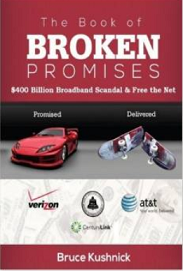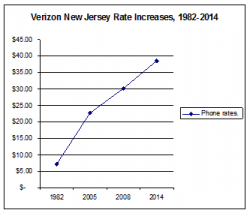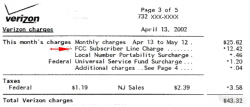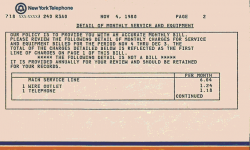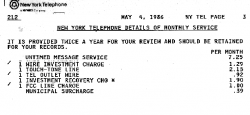We Solved Net Neutrality — Plan for Solving America’s Communications Issues.
Conclusion: Summary of the series based on the report “It’s All Interconnected”—and What Should America Do Next.
As we discussed in “Fast Lane, Slow Lane, No Lane, End Game in Communications”, Net Neutrality is really not the primary issue— it is a symptom of underlying problems that need to be solved.
Here is a summary what we found and then we will present a plan for solving Net Neutrality and America’s communications issues.
Backdrop:
In 1996, the Telecommunications Act was passed to open up the ‘last mile’, or first hundred feet, the wire to the customers home or office which would allow independent ISPs and competitive local exchange companies, CLECs to use the existing wires to offer competitive services.
In 2004, led by then chairman Michael Powell, (now head of the cable association, NCTA), the networks were closed to competition. This was accomplished by classifying broadband and internet as one service – an ‘information service’, (Title I) which did not have the obligations that a ‘telecommunication’ service has, (Title II). Prior to this, broadband was always a telecom service, and the networks had been ‘opened’
The FCC has tried multiple times to make the ‘internet’ open, by attempting to add ‘telecom-like’ obligations, and in 2014 Verizon won a legal challenge — claiming that the FCC Open Internet order should not stand — and that ‘reclassifying’ broadband as “Title II” harmed investment and innovation.
Smoking Gun: Verizon’s FiOS Fiber Optic Networks Are Already Based on Title II, since at least 2005.
- Net Neutrality Solved: Verizon’s FiOS Rides Over a Title II, Common Carriage, FTTP (Fiber-to-the-Premises) Telecommunications Network
We checked multiple municipalities, cities and even system-wide cable franchises and in every one Verizon has used the Title II classification for the deployment of its FTTP, Fiber-To-The-Premises’ networks.
2) Verizon claims that Reclassifying broadband Internet access service as a Title II …would only endanger the entire Internet ecosystem.”
And this is in direct contradiction to Verizon own statements that claims that it has invested billions in FiOS and that reclassification would be a major drag on broadband infrastructure deployment
- Verizon’s Open Internet Comments “Verizon has invested tens of billions of dollars to build our wired and wireless broadband networks, including more than $23 billion spent to construct our fiber-optic FiOS network since 2004, and we continue to expend large sums to improve and grow those networks.”
- Verizon’s blog “Reclassification would create a major drag on new and improved broadband infrastructure”,
If FiOS is already Title II, these statements contradict their own current deployments.
3) “Title Shopping” Exposed: Verizon’s FiOS is Based on a Title II, FTTP Network. Shame They Never Told the Court, the FCC or the Public.
Searching Verizon’s filed FCC comments as well as examining the court documents and transcripts, we could find no mention of Verizon telling the FCC or court that the current networks use Title II for the deployment of their premier fiber optic networks.
We found “Title Shopping”, where Verizon uses different classifications for the same service to maximize regulatory benefits. But when compared, there are major legal questions that arise as it is not legal to charge local phone customers for the deployment of a cable service (Title VI) or for an information service, (“Title I”).
Did Verizon violate the law and regulations with its failure to disclose, at every turn, the company’s reliance on Title II for its broadband networks
Why Use Title II: Charge Basic Rate Phone Customers for the construction of the FTTP Networks and Rights of Way.
4) Verizon NY Used Title II so that they could Charge ‘Basic Rate’ Phone Customers Rate Increases for the Deployment of the FiOS, FTTP Networks
In New York State, Verizon was able to get multiple rate increases on “POTS”, (“Plain Old Telephone Service”) customers to fund a ‘massive deployment of fiber optics’ and because of substantial financial losses.
And Verizon had massive losses. From 2008-2012, Verizon New York lost $11 billion dollars, over $2 billion a year, which gave the parent company, Verizon Communications a $5 billion dollar ‘tax income benefit. And, Verizon paid no taxes and used the losses to raise rates.—I’ll return to this in a moment.
Verizon used Title II so that the FTTP networks would fall under the state laws as part of the utility network upgrades. Starting in 2006, customers paid an additional $500.00 per line through rate increases and additional taxes, fees and surcharges. Using Title II also gave Verizon the utility rights-of-way and all that is associated with that.
5) Did Verizon Short Change “Upstate” New York and are POTS Customers and Low Income Families Paying for Fiber Optic Services They Will Never Get?
Verizon New York has stated it had completed its FiOS deployments in the state, and except for outstanding obligations, Verizon is leaving 80% of the municipalities without upgrades even though ALL POTS customers were hit with rate increases to fund the construction and deployment of the FTTP networks.
This is a double-whammy on low income families as they not only paid extra for services, but as many of the New York State mayors of major cities stated, low income areas were left out of the Verizon FiOS plan
Cross-Referencing Verizon’s Accounting Financials from Different Sources Revealed Black Hole Revenues and Construction Cost Issues.
6) Verizon New York’s Multiple Financial Books Reveal “Black Hole Revenues”.
The Verizon New York rate increases on basic rate customers were granted based on ‘massive deployment of fiber optics and extensive losses.
When we examined Verizon’s financial accounting, presented in their SEC filings and their state-based PSC filings for the year 2009 we found that the SEC filings had an additional $2.7 billion dollars as compared to the PSC annual report for the same year. And there was no information provided about these extra revenues — and we dubbed it ‘black hole’ revenues.
When we compared the construction budgets for these two financial books we found that they were identical, indicating that the black hole revenues paid no construction costs, at least that was in the Verizon New York books.
NOTE: The FCC’s data stopped in 2007 but the FCC never examined the total revenues for any state, but only presented the regulated books — the Verizon New York PSC books.
Verizon’s Affiliate Companies have Taken Control of the Wires
7) Verizon Phone Bill Quiz: You Won’t Get Any Answers Right.
8) How Verizon’s Affiliates Took over this Broadband, Internet and Phone Bill.
While most people think that ‘Verizon’ is the only company offering services on a double or triple play bill, truth is there are multiple affiliates and partners that offer service.
We created a short quiz for people to identify the four different affiliate companies and partners that were offering a customer services on their Verizon New York 1 line account.
Affiliates are Paying Incremental Costs—and Not the Building of the FTTP Networks.
The ‘regulated books’ in the Verizon New York Annual reports are based on the Uniform System of Accounts, (USOA) and so the conclusion by our experts is that the Verizon Online, Verizon Business, and other services, which are based on IP protocols or ‘information’ services are most likely in the ‘black hole revenues’. This indicates the broadband, Internet, cable and VOIP phone services are probably paying ‘incremental costs’ and not the costs of building the FTTP networks, which are Title II.
And this, in part, created the losses in the state utility, that was used for rate increases.
The Secret Second Network: Special Access and the Wireless-Wired Ties.
9) How Verizon and AT&T Control Communications by Manipulating ‘Special Access’ — Is Special Access Really $60 Billion in the US?
There are two classes of service;
- Retail services to residential and business customers, which we’ve seen has a bottleneck created by the vertical integration of phone, broadband, internet and cable over 1 wire.
- Special Access, also called backhaul or middle mile, which are the wires in the middle of the networks and can be data services as well as competitor services. Sprint and T-Mobile pay AT&T and Verizon for these networks as they have monopolies on their incumbent wires. They are also part of ‘interconnection’ and peering –networks that content providers like Netflix use with an “ISP”,
And Special Access services are “secret” because the FCC stopped providing any data in 2007.
We found that there are special access services (using Title II) in the regulated PSC books that are now larger in revenue than local service. However, local service paid a disproportionate amount for ‘plant specific’ expenses as compared to access services in general.
But the kicker is that the “IP based and fiber optic based special access services appear to be in the ‘black hole’.
Using Verizon New York, we estimate that the total revenues was almost $30 billion in 2013, while the black hole revenues are probably as large, bringing the total US market to almost $60 billion. (Other analysts claim the market is just $12-$15 billion, but they rely only on previous FCC data.)
Verizon Wireless and Wireline Ties
Verizon Wireless appears to have the expenses for the special access wires to the cell towers paid for by the wireline construction budgets, i.e., Title II local service. At the same time, Verizon Wireless appears to be paying a fraction of what the competitors are paying.
Moreover, when Verizon and AT&T state that they are ‘shutting off the copper’ in areas, they aren’t shutting off these customer-funded wires dedicated to wireless and since these wires are monopoly products and are used by the wireless competitors, Verizon makes money on all wireless calls.
Net Neutrality Solved —a Plan for Solving America’s Communications Issues.
“Fast Lane, Slow Lane, No Lane, End Game in Communications”. These are the some of the issues that are currently facing America’s communication customers and competitors.
Net Neutrality is caused by a bottleneck where the cable, phone, broadband and Internet services provided over 1 wire are controlled by 1 company and the affiliates also get major advantages, placing competitors at a disadvantage. It also gives controls of tied-products so that the ISP and broadband, together can slow down a service or block or degrade a service. And it controls the price, quality and speed of service.
But controls over the wire also give the company controls over who gets upgraded and who doesn’t, who will shut off and who will end up in a ‘Digital Dead Zone.
Time for a change.
What the FCC, Courts, States Commission need to do:
We will focus on Verizon as it was the company that took the FCC to court.
STEP 1: The FCC must Acknowledge that Verizon’s FTTP networks are already Title II and Investigate the Implications.
We are almost speechless when we see that Verizon’s entire FTTP networks are already using Title II and that Verizon never disclosed this fact to either FCC or the courts—or that the FCC never found and questioned Verizon about this.
Simply put: The FCC must:
- Acknowledge that Verizon’s entire fiber optic networks are Title II already.
- Investigate Verizon’s current use of Title II and whether Verizon’s failure to disclose this fact violated laws or ethics to the FCC or the court.
- With the States jointly work to examine “Title Shopping”—gaming the regulatory system.
- There is no need for reclassification—Verizon’s networks are already Title II.
STEP 2: The FCC and the States Needs to Investigate how Title II Was Used to Make Regular Phone Customers ‘Defacto Investors’ of the FTTP Networks.
In New York, Verizon was able to get rate increases of POTS, plain old telephone service, customers to fund these networks. This includes low income families, small businesses, municipalities, and anyone still using the copper networks.
What the FCC and States need to do:
- The FCC must examine the fact that basic rate phone customers have been the defacto investors of Verizon’s fiber optic networks.
- States need to examine the rate increases in light of funding FiOS and the FTTP networks, where they may never benefit.
STEP 3: Follow the Money and the Controls: The FCC Must Examine The Affiliate Companies Control Over the Wire and the Flows of Money.
On July 1st, 2014, a newly formed group “Connect New York Coalition” filed a petition with the NY State Public Service Commission to investigate the telecommunications companies in New York State – including Verizon.Read the Petition, Coalition members
Consisting of AARP, Consumer Union, Communications Workers of America, Common Cause, among others, the Petition is based, in part on the PULP-New Networks report (the basis of this series) and New Networks previous report.
This investigation requests include
- Did the affiliate companies to put expenses into the state-based utility that caused losses.
- Were wired construction budgets diverted to fund wireless instead of properly upgrading and maintaining the state infrastructure.
What the FCC Must Do:
- Start an investigation into the flows of money between the state-based utility (and title II), and the affiliate companies
- A specific investigation needs to be done of the wireless and wired-businesses relationships.
- Do a specific investigation of the ‘special access’ revenues, expenses, the use of the Title II classification and the ties to the state utility networks.
Step 4: The FCC Needs To Get Serious About Data and Analysis—Finally.
The Companies hide most of this behavior because the regulators stopped collecting data.
- Verizon stopped publishing the SEC-filed state-based financials in 2010. Moreover, AT&T hasn’t filed separate SEC reports for at least a decade.
- The FCC abolished the data collection in 2007 of the “Statistics of Common Carriers” and the FCC has never collected the ‘black hole’ revenues that appeared in the SEC filed reports for any state, much less Verizon New York.
- The New York PSC reinstated the filing of Annual report financials in 2009 but no other state commission, has anything resembling this level of detail.
And even the New York PSC data is still missing basic data. A simple example — we do not know the actual number of “total lines in service” by Verizon New York or the affiliates, nor how many are copper or fiber.
The FCC needs to
- Re-establish data collection that includes the information supplied by the FCC’s ARMIS and Statistics of Common Carriers.
- examine the separate subsidiary rules and data collection, that were
STEP 6: FIX Communications: Open the Networks, Separate the affiliates, and Move Towards Open, Universal Fiber Utilities.
After all the data is collected, so that the FCC and states have a clear picture of the last decade of business practices by the incumbent phone companies and their affiliates, we believe that the only logical steps:
- Open the Networks to All forms of Competition
- Reestablish the wholesale use of the networks
- Separate the affiliates from the controls of the wires
- Make the affiliates pay market prices.
- Return the customer-funded assets to the state-based utility
- separate the wireless company from the wired company
The Economics of Title II:
If the affiliate companies paid their fair share, stopped dumping affiliate expenses into the state utility, and returned the customer-funded assets, such as special access, the state utilities could deploy fiber optics to all homes and premises.
Today, the construction budgets were diverted to not build out the networks, to build out the wireless business, and the affiliate excess caused a large part of the losses.
While Verizon will claim all of this is a ‘takings’, it is — a takings from customers who have become defacto investors in the creation and expanse of the affiliate businesses.
As we started, FiOS is Title II, common carriage and was funded via rate increases based on ‘massive deployment of fiber optics’. If Customers paid for it, and it is Title II, they are entitled to upgrades—everywhere in the franchise area.
Cities and States must also start this process as it is clear that there has been regulatory neglect to the point of severe harms.
- Getting Cities and States Wired
- Getting Rural Areas Wired
